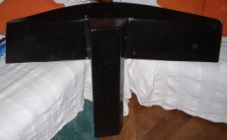And also would a maestro 1600 a series engine drop straight in a mini?
Thanks in advance!

Posted 28 October 2005 - 12:53 PM
Posted 28 October 2005 - 01:10 PM
Posted 28 October 2005 - 01:13 PM
LOL what am i saying.Thats is that a RWD engine????
This should suit any car with a rear wheel drive A-series engine, such as a Marina or 1275 MG Midget or Sprite. I kept it because I was planning to get a Midget at some point later. The buyer should do the research to make sure it is going to fit!
Posted 28 October 2005 - 01:32 PM
Posted 28 October 2005 - 01:41 PM
Posted 28 October 2005 - 02:39 PM
Edited by GuessWorks, 28 October 2005 - 02:41 PM.
Posted 03 November 2005 - 01:17 PM
Yes S series or R series depending on the year.1600 Maestro engine is not a series (s-series I think)
Wil
Posted 03 November 2005 - 01:24 PM
Posted 03 November 2005 - 03:59 PM
Posted 03 November 2005 - 04:10 PM
Edited by GuessWorks, 03 November 2005 - 04:11 PM.
Posted 04 November 2005 - 11:12 AM
I couldn't work out if you were referring to me but it was under my post. The 1600 in the Maestro and Montego is definitely R or Series.O series actually, and it's not RWD either but transverse FWD...
Posted 04 November 2005 - 11:27 AM
O-Series finally launched
The first production car to use the O-Series arrived in 1978 - and that was the Marina. Sadly, Harry Webster's preferred plan of offering the O-Series in 1.6- and 2-litre form was scuppered by the cost advantages of using 2-litre version's head casting on the smaller unit, raising the capacity to the unusual size of 1.7-litres. Advantages over the B-Series unit were a lower all-up weight, but in terms of refinement and performance, the motoring press found little to get excited about.
Shortly afterwards, the O-Series Princess 2 appeared - and this was the first showing of the larger 2-litre version. The 1994cc unit produced a less than sparkling 93bhp at 4900rpm in single carburettor form, and did nothing to improve the Princess reputation with buyers for being a slow car.
That is not to say that the O-Series was without its merits; only that it was a bit of a "rough diamond" in the early years, offering little advantage over the outgoing B-Series - certainly in terms of performance and refinement. As stated though, it was a good 20kgs lighter than the B-Series engine, and the block was shorter and therefore easier to package. Also, the aluminium cylinder head allowed for unleaded fuel usage... (it is a shame that the O-Series powered MGB never made it).
It was also usefully reliable.
It also figured in Austin-Rover's 1980s plan for prosperity.
In 1980, the first rear wheel drive 2-litre O-Series powered car appeared: the Ital 2.0 Automatic. In 1982, a 2-litre twin carb version was installed under the Rover SD1's sleek bonnet, and then in transverse form in the Ambassador. In 1984, it appeared in the Montego and Maestro with an end-on Honda designed gearbox (and very effective it was, too) - so there was no doubt that the O-Series was an adaptable engine.
Of course, the O-Series story did not finish with the Maestro and Montego - and after an intensive development programme during the mid-1980s, it was transformed into the twin-cam 16V M-Series...
Fundamentally, the O-Series was a good engine, and if nothing else, demonstrates that when asked, BL could get the job done in the most trying of circumstances. Perhaps, it was launched when in need of final development, but given the lack of resources available to BL at the time, it is a miracle that it appeared at all.
0 members, 1 guests, 0 anonymous users